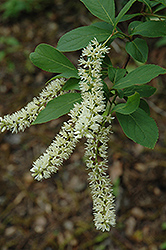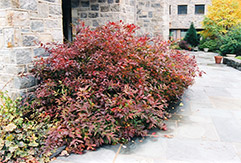Height: 4 feet
Spread: 5 feet
Sunlight:
![]()
![]()
![]()
Hardiness Zone: 6b
Description:
A pretty native shrub which features long, narrow panicles of white flowers in early summer, spreads to form colonies, excellent blend of fall colors; not commonly found in gardens but definitely worthy, excellent for naturalizing
Ornamental Features
Virginia Sweetspire has racemes of fragrant white flowers at the ends of the branches in early summer. It has green deciduous foliage. The narrow leaves turn an outstanding red in the fall. The smooth brown bark and purple branches add an interesting dimension to the landscape.
Landscape Attributes
Virginia Sweetspire is a dense spreading deciduous shrub with a ground-hugging habit of growth. Its average texture blends into the landscape, but can be balanced by one or two finer or coarser trees or shrubs for an effective composition.
This shrub will require occasional maintenance and upkeep, and should only be pruned after flowering to avoid removing any of the current season's flowers. Gardeners should be aware of the following characteristic(s) that may warrant special consideration;
- Suckering
Virginia Sweetspire is recommended for the following landscape applications;
- General Garden Use
- Naturalizing And Woodland Gardens
Planting & Growing
Virginia Sweetspire will grow to be about 4 feet tall at maturity, with a spread of 5 feet. It tends to fill out right to the ground and therefore doesn't necessarily require facer plants in front. It grows at a medium rate, and under ideal conditions can be expected to live for 40 years or more.
This shrub performs well in both full sun and full shade. It is an amazingly adaptable plant, tolerating both dry conditions and even some standing water. It is not particular as to soil type or pH. It is somewhat tolerant of urban pollution. This species is native to parts of North America.
Disclaimer - This resource is provided for informational purposes only and does NOT reflect current availability. Inventory varies seasonally, so we cannot guarantee that every plant will be in stock at all times - please contact your favourite GardenWorks location directly for current availability. It does not include our entire inventory of plants, so be sure to visit GardenWorks to see varieties that may not be represented on this list.


